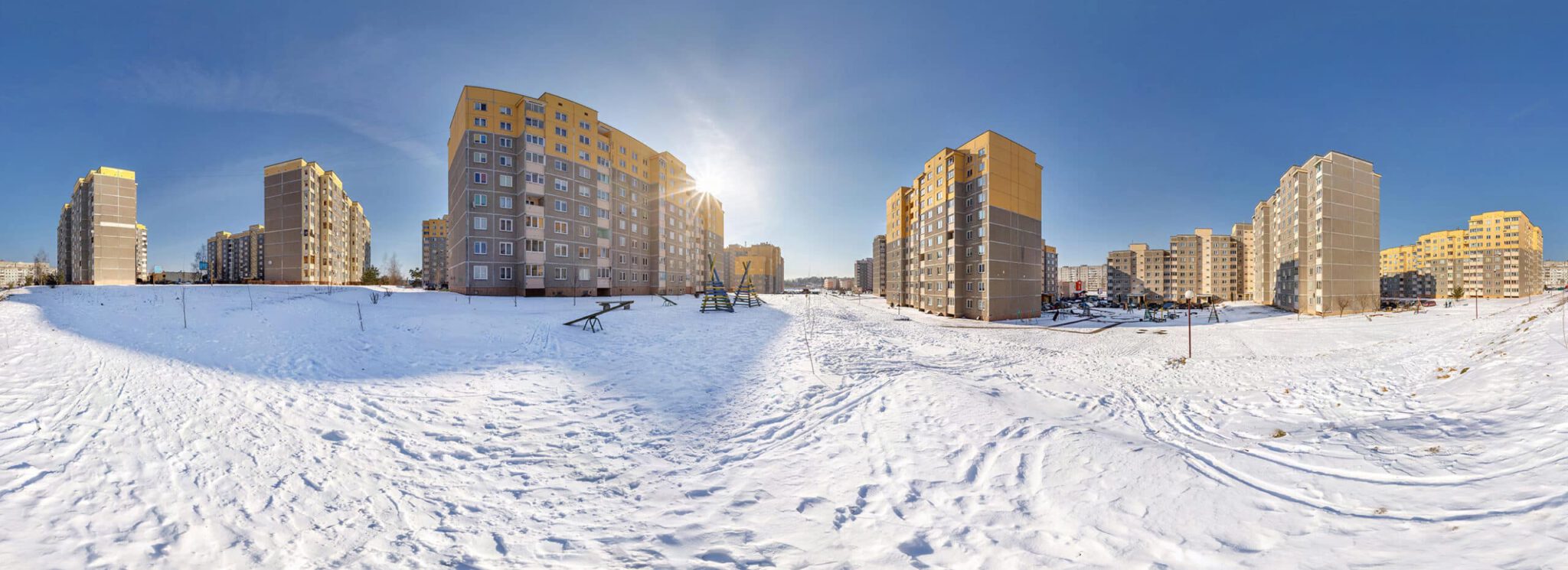Winter is coming. Sort of. In Texas, for example, you’ll see several 40-degree days and then 60- or 70-degree temperatures for a few days. Repeat. That’s the worst kind of winter because the wild swings in temperatures can do a lot of damage to apartments and commercial properties.
The temperatures can fall below freezing and freeze the pipes. Then, the next day the weather warms up causing these frozen pipes to thaw instantly and possibly flood the property. According to the Insurance Information Institute, it’s a serious problem considering 2018 winter in the U.S. caused about $3 billion in insured losses. This is more than double 2017’s $1 billion.
The steps you take can secure and protect your commercial properties and apartments to minimize damage and prevent accidents. Here are eight security tips for maximizing safety and security in the winter months.
1. Create a Winter Plan
Considering you’ll need to winterize your properties every year, it’s wise to document a plan that you can use every winter. Think of it as your annual checklist to ensure you don’t miss a step.
The plan covers tenant education, winterization checklists, and winter weather procedures. Here’s an example of a procedure: if a pipe bursts in the basement, what actions do you need to take? Evacuate the building? How will you notify your tenants and employees to exit the building? List every possible thing that can go wrong and what to do when it happens.
Create a process for salt and sand. Do you get snow or ice? How much salt and sand do you need to cover your property? Do you have a place to store it until you need it?
Another thing to keep on hand is portable lighting. The more your tenants can see, the less likely they will fall or crash their vehicle. Portable lighting can come in handy for special events and other unexpected situations. You may want to have battery-powered lighting on hand in case of a power outage.
Add property inspection in the plan. List what you’ll inspect and what to verify. For instance, inspect the sidewalk to identify slippery areas, cracks, and other obstructions that could cause someone to trip. You’ll also want to check handrails to see if they are secure or loose.
2. Review Exterior Lighting
Shorter days affect everyone’s ability to see when outside. Do a review of your exterior lighting, everything from the entrances and walkways to the parking lot and stairwells. You want everyone to always feel safe when walking around your property.
It’s especially critical to confirm that all lights remain fully operational during the winter months. So, it helps to schedule light checks more often. It may be worth bringing in a security consultant for lighting security tips.
Ask the consultant about motion-activated lights and whether it would be ideal for your commercial property. The sudden flooding of your area with bright lights can scare trespassers away. They feel like a spotlight shines on them draws attention their way.
The consultant can study the location of the lighting and the type of lighting used. Many people don’t realize that brighter is not necessarily better lighting. The consultant can examine how much lighting you have and ensure you don’t have too little or too much. Too little leads to shadowy spots while too much leads to wasteful spending.
3. Lock Doors and Windows
Common sense says to always keep doors and windows locked. Reality says differently. An apartment building may not lock the front door to make it easier for residents to enter. However, this allows non-residents to easily walk in with everyone else.
Yes, unlocking the door is an extra step, but most homeowners keep their front doors locked whether they’re home or not. The front door of an apartment building should be no different.
The same applies for commercial buildings. It depends on the purpose of the commercial building. A building filled with doctor’s offices needs to give patients an easy way in. A good workaround is to station someone at the front desk or use video surveillance cameras.
4. Inspect the Property
Remember that winter plan you created? It has a section on inspecting the property to check for safety. Walk the property and watch for problem spots on sidewalks, driveways, and parking lots and garages. Confirm handrails remain secure and the landscaping is free of debris that could trip people or create hiding places.
5. Clear the Snow
Your best option for snowplowing is to hire a qualified professional. They have the equipment, insurance, and training to do the job safely and correctly. If you don’t have a contractor, start the process so you have them on standby before the next snowstorm hits.
6. Stock or Restock De-icing Supplies
Ice is hard to see, and residents may miss it. Stay on top of weather reports on ice and act based on what you use for de-icing. Temperatures can affect salt and sand performance. The best type of de-icing material to use depends on your property. It’s worth contacting the professionals to find out what they recommend and how to properly use it. Like with snowplowing, you may want to have a contractor on standby.
While rock salt is cheap, it’s corrosive to concrete and does not work when temperatures fall below 12°F. Calcium chloride is more expensive. Its advantage is that it can handle temperatures as cold as -20°F. Hopefully it doesn’t get colder than that on your property.
Calcium magnesium acetate is less corrosive than rock salt. The challenging part of using it is that you must apply it before the bad weather occurs. While it doesn’t melt ice, it makes removal faster and easier. Beware, it does not work below -20°F.
7. Educate Tenants
One of the most effective ways to minimize risk is to educate tenants on winter safety and security tips. Involving them benefits everyone as they provide extra eyes on the property.
Here are the security tips to cover:
- Discuss fire safety and procedures as apartment fires can spread fast.
- Explain how to find and report problems with furnaces, electrical, heating, and detectors.
- Advise against portable heaters or confirm they follow safety standards.
- Provide tips on how to safely decorate for the holidays.
- Check smoke and carbon monoxide detectors and batteries.
- Share recommendations for safe cooking to minimize fire risk.
- Ask they report any safety hazards including loose railings and broken flooring.
You may have an online community
for your residents, send them email updates, or hold educational meetings on a monthly or a quarterly basis. Whatever route that allows you to best reach your tenants, use that to educate them.
8. Review Your Apartment and Commercial Property Security
Do you have an apartment security system? Video surveillance? How old is it? Is it in working order? Video surveillance has come a long way from the days of grainy video. It’s also cheaper and more effective. Video surveillance systems have reached a point where they can deter crime and help prevent damage from happening.
However, not just any video surveillance system can achieve this. You want to invest in one with high resolution cameras and monitoring that uses advanced video analytics. It can automatically detect suspicious activities and filter video without human intervention.
The way this works is that the video surveillance company defines specific events, such as a person approaching the property. When the camera detects this, it notifies a security operator who checks out the activity and acts as needed.
A video surveillance system may include an audio speaker function. This allows the person watching the cameras alert the trespassers without being on the property. Often, this will send the trespassers scurrying away. For times they don’t scare easily, the monitoring operator calls the police and keeps them apprised of the suspects’ movements.
The cool thing about video surveillance is that it can do more than deter crime. It can monitor for flooding, safety hazards, and customer service problems. It can help catch employee theft and help prevent fraud. On occasion, an incident happens that isn’t caught until later. You can have security consultants search and analyze hours of video much faster than if you go at it alone.
Like any other technology, video surveillance needs regular maintenance and system health checks. No one wants to learn something suspicious happened only to find out the cameras did not see it or capture it.
Why not opt for onsite security guards? Unlike the eyes of the strategically placed cameras, security guards cannot see or be everywhere. They can only watch one area at a time. And when they spot something, they can’t record it to use as evidence.
Yes, they have cell phones, but when something suspicious arises, they may not think about whipping out the phone to record the incident. They are focused on their own safety and finding a safe resolution.
The Need for Security
Every property is different. The property owner and manager have a responsibility to ensure the property is safe for tenants, employees, vendors, and visitors. That’s why it’s critical to create a plan with the steps to keep the property safe in the winter.
If tenants are responsible for keeping their area clear, then it needs to be in the contract. Otherwise, the property could be held liable for injuries and damages when it didn’t do something about it.
Many valuable video surveillance solutions exist today. Your property can get exactly what it needs when it works with a security company like Stealth. You let us know your budget and requirements. We’ll customize a security solution to meet those needs. To learn more about how this works, contact us.

